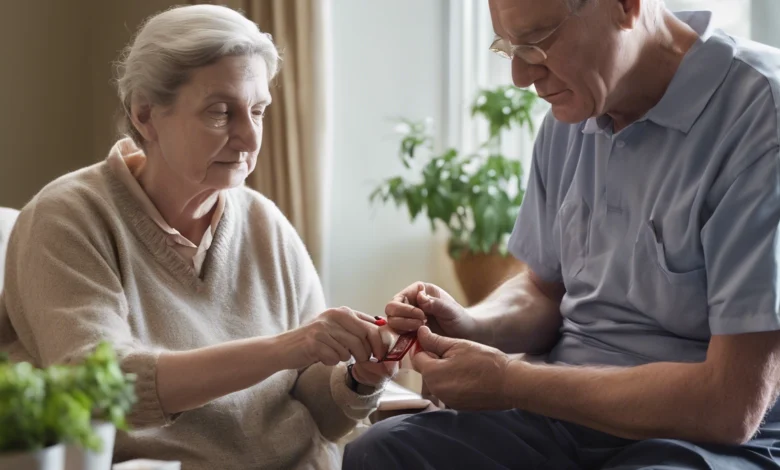The Importance of a Caregiver in Type 2 Diabetes

Introduction
A caregiver in type 2 diabetes is particularly important because self-management is key to successful management of this disease.
T2D can sometimes be unpredictable, and if your blood glucose suddenly gets too low or too high and you are unable to help yourself, you may need quick corrective action, which can only be done by someone familiar with your disease condition.
Once you have been diagnosed with type 2 diabetes, one of the first things you need to do is to disclose your condition to someone you trust.
While self-management is crucial, having a caregiver (learn more) or confidante can make a significant difference in a diabetic’s overall health and emotional well-being.
A caregiver is even more important when the patient is elderly or has a disability.
Why is a Caregiver Crucial in Type 2 Diabetes Management?
Diabetes is not just a physical condition—it affects mental and emotional health as well. The daily demands of monitoring glucose levels, making healthy food choices, staying active, and managing medications can feel overwhelming. (read more here)
A supportive caregiver in T2D or trusted confidante can provide:
1. Encouragement & Accountability
A caregiver can help reinforce healthy habits, such as reminding the diabetic individual to take medications or encouraging them to stay active.
They can provide gentle accountability for dietary choices, helping to prevent unhealthy eating habits.
2. Emotional Support & Reduced Stress
Managing diabetes can lead to stress, anxiety, and even depression. A confidante offers a listening ear, reducing feelings of isolation.
Emotional support helps lower cortisol levels, which can indirectly improve blood sugar control.
3. Assistance in Medical Management
A caregiver can help track blood sugar readings, (learn more here), recognize warning signs of highs or lows, and assist during emergencies (e.g., hypoglycemia).
They can accompany the diabetic individual to doctor’s appointments, ensuring better communication and understanding of treatment plans.
4. Improved Adherence to Treatment Plans
Many people with diabetes struggle with medication adherence. A caregiver can help organize pills, set reminders, and ensure prescriptions are refilled on time.
They can also assist in meal planning and preparation, making it easier to follow a diabetes-friendly diet.
5. Emergency Preparedness
In cases of severe hypoglycemia (low blood sugar), a caregiver can recognize symptoms (confusion, dizziness, sweating) and administer glucose or call for help.
They can also be trained to use a glucagon learn more here kit if needed.

Who Can Be a Caregiver in T2D?
A support person doesn’t have to be a professional—it can be:
A spouse, family member, or close friend
A support group (in-person or online)
A diabetes educator or health coach
Key Roles of a Caregiver for Type 2 Diabetes Medication Management
A dedicated caregiver has many roles to play in assisting a patient to manage type 2 diabetes. Here is a list of roles you can play:- (learn more here)
- Ensure timely intake of oral medications or insulin.
- Help prevent missed doses or incorrect dosages, which can lead to dangerous blood sugar fluctuations.
- Diet and Nutrition Support
- Assist in meal planning to maintain a balanced, low-glycemic diet.
- Monitor portion sizes and carbohydrate intake to prevent blood sugar spikes.
- Encourage healthy eating habits and reduces temptation from unhealthy foods.
- Monitor Blood Sugar Levels
- Help with regular glucose testing, especially for those with vision or mobility issues.
- Recognize signs of hypoglycemia (low blood sugar) or hyperglycemia (high blood sugar) and take appropriate action.
- Encourage Physical Activity
- Motivate and assist with safe exercises like walking, swimming, or light strength training.
- Ensure consistency in physical activity, which improves insulin sensitivity.
- Give Emotional and Psychological Support
- Provide encouragement to reduce stress, which can negatively impact blood sugar levels.
- Help prevent diabetes burnout by offering companionship and motivation.
- Coordinate Medical Appointments
- Schedule and accompany the patient to doctor visits, eye exams, and foot check-ups.
- Help communicate concerns to healthcare providers and follow up on treatment plans.
- Emergency Preparedness
- Recognize diabetes-related emergencies (e.g., severe hypoglycemia or diabetic ketoacidosis).
- Know when to administer glucose tablets or glucagon and when to seek emerg
How to be an Effective T2D Caregiver
If you’re a caregiver or confidante for someone with Type 2 Diabetes, here are some ways to help:
✔ Educate yourself about diabetes to better understand their struggles. (learn more here)
✔ Offer non-judgmental support—avoid shaming food or lifestyle choices.
✔ Encourage, don’t control—support their autonomy while gently guiding them.
✔ Be patient—diabetes management is a lifelong journey with ups and downs.
Final Thoughts
Type 2 Diabetes is easier to manage with a strong support system. Whether it’s a family member, friend, or professional caregiver, having someone to share the journey with can lead to better health outcomes and improved quality of life.
If you are a caregiver in type 2 diabetes, don’t hesitate to reach out for support—and if you know someone managing this condition, your encouragement could be life-changing.
Benefits of Having a Caregiver include:-
✔ Better blood sugar control (reduced HbA1c levels).
✔ Lower risk of complications (neuropathy, kidney disease, vision problems).
✔ Improved quality of life and mental well-being.
✔ Reduced hospitalizations due to better disease management.
.

Strengthening the Role of a Caregiver in T2D
Formal Training Programs:
1 Education & Training
Structured courses on caregiving techniques, first aid, medication management, and disease-specific care.
Workshops & Seminars: Offer sessions on stress management, communication skills, and behavioral strategies.
Online Resources: Utilize webinars, e-learning modules, and caregiving apps for continuous learning.
Counseling Services: Access to therapists or support groups
2. Emotional & Psychological Support
to manage caregiver burnout, depression, or anxiety.
Peer Support Networks: Facilitate caregiver support groups (in-person or online) for shared experiences and advice.
Respite Care: Temporary relief through professional respite services to prevent exhaustion.
3. Financial & Legal Assistance
Government & NGO Aid: Explore subsidies, grants, or tax benefits for caregivers (e.g., Medicaid, VA benefits).
Legal Guidance: Help with guardianship, power of attorney, and healthcare directives.
Flexible Employment Policies: Advocate for workplace accommodations (remote work, flexible hours).
4. Improved Work-Life Balance
Time Management Tools: Use scheduling apps or journals to organize care tasks efficiently.
Delegation: Share responsibilities among family members or hire part-time help.
Self-Care Practices: Encourage regular breaks, exercise, and hobbies to maintain personal well-being.
5. Technology & Tools
Assistive Devices: Use mobility aids, medication dispensers, or monitoring systems (e.g., fall detectors).
Telehealth Services: Remote consultations with doctors to reduce caregiver burden.
Care Coordination Apps: Platforms like CareZone or CaringBridge to track medical records and appointments.
6. Strengthening Communication
Clear Dialogue with Healthcare Providers: Ensure caregivers are included in medical discussions.
Family Meetings: Regular check-ins to align on care plans and responsibilities.
Advocacy Training: Teach caregivers how to effectively advocate for their dependents in medical or social settings.
7. Community & Social Integration
Community Programs: Engage in local senior centers, disability-friendly activities, or daycare services.
Volunteer Networks: Connect with organizations that offer volunteer assistance for caregivers.
Public Awareness Campaigns: Reduce stigma and promote understanding of caregiving challenges.
8. Policy & Advocacy
Lobby for Better Caregiver Rights: Push for policies like paid family leave and caregiver tax credits.
Inclusion in Healthcare Planning: Ensure caregivers are recognized as part of the care team in medical settings.
9. Personalized Care Plans
Tailored Approaches: Adjust care strategies based on the dependent’s evolving needs.
Regular Assessments: Periodic evaluations with social workers or doctors to update care plans.
10. Recognition & Validation
Acknowledgment of Efforts: Celebrate caregivers through appreciation events or awards.
Normalize Caregiver Challenges: Public discourse to reduce isolation and guilt associated with caregiving struggles.
Conclusion
A caregiver plays a vital role in helping a Type 2 diabetic manage their condition effectively. Their support can lead to healthier habits, fewer complications, and greater independence for the patient.
If you’re a caregiver, educating yourself about diabetes management and working closely with healthcare providers can make a tremendous difference in your loved one’s health.
Enhancing the caregiver’s role requires a multifaceted approach combining education, emotional support, financial aid, technology, and policy changes. By implementing these strategies, caregivers can provide better care while maintaining their own health and quality of life.


ssgeszlhemsfhwlgudsqnwzhurvdrp